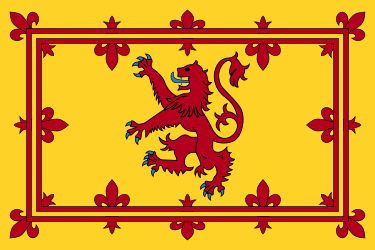by Susan Flantzer
© Unofficial Royalty 2015

Seal of William I, King of Scots; Credit – Wikipedia
William I, King of Scots, nicknamed “the Lion,” had the second-longest reign in Scottish history before the Act of Union with England in 1707. He reigned for 49 years, from 1165 – 1214, and was a contemporary of King Henry II of England and his sons King Richard I and King John. Born around 1143, William was the second son of Henry of Scotland, 3rd Earl of Northumberland and the 3rd Earl of Huntingdon and Northampton (who was a son of David I, King of Scots) and Ada de Warenne. William was not known as “the Lion” in his lifetime. The nickname did not refer to his personality or his military ability but referred to his standard, a red lion rampant with a forked tail on a yellow background. This became the Royal Standard of Scotland and is used today on the Royal Standard of the United Kingdom, quartered with the royal standards of England and Ireland.

The royal standard of Scotland; Credit – Wikipedia
William had six siblings:
- Malcolm IV, King of Scots (1141 – 1165), unmarried
- Margaret of Huntingdon (1145–1201) married 1) Conan IV, Duke of Brittany, had one daughter Constance, Duchess of Brittany who married Geoffrey Plantagenet, son of King Henry II of England, 2) Humphrey III de Bohun, had issue
- David of Scotland, Earl of Huntingdon (c. 1144 – 1219), married Matilda of Chester, had issue
- Matilda of Huntingdon (born and died 1152)
- Marjorie of Huntingdon, married Gille Críst, Earl of Angus
- Ada of Huntingdon (c. 1146 – c. 1206), married Floris III, Count of Holland, had issue
Upon the death of his grandfather David I, King of Scots, William’s elder brother succeeded to the throne as Malcolm IV, King of Scots because David’s only son, Malcolm and William’s father Henry, had predeceased him. Malcolm died in 1165 at the age of 24 and William became King of Scots. William was crowned and anointed at Scone Abbey on December 24, 1165.
Malcolm IV had been forced to surrender Northumberland, Cumberland, and Westmoreland to King Henry II of England and to acknowledge Henry II as his overlord. In 1173, rebellious English barons enticed William to join their cause with the promise of the return of Northumberland. William invaded England but was taken prisoner at the Battle of Alnwick on July 13, 1174. The Treaty of Falaise obliged William to acknowledge Henry II as his overlord, agree to pay for the cost of the English army’s occupation of Scotland by taxing the Scots, and to surrender several castles as security. William was released on February 2, 1175, and allowed to return to Scotland. The treaty was canceled in 1189 when King Richard I of England effectively sold southern Scotland back to William to help fund his crusade in the Holy Land.
In 1178, William founded Arbroath Abbey in memory of the martyred Saint Thomas Becket, whom he had met at the English court. Henry II restored the Earldom of Huntington (which still exists today) to William in 1185 who then granted it to his brother David. During William’s reign, settlements were extended and new ones were founded, criminal law clarified, the responsibilities of justices and sheriffs became greater, and trade grew.
The terms of the Treaty of Falaise gave Henry II of England the right to choose William’s wife. As a result, William married Ermengarde de Beaumont, a great-granddaughter of King Henry I of England (through an illegitimate child of Henry I), at Woodstock Palace in Oxfordshire, England on September 5, 1186. William and Ermengarde had four children:
- Margaret (1193–1259), married Hubert de Burgh, 1st Earl of Kent, had issue
- Isabel (1195–1253), married Roger Bigod, 4th Earl of Norfolk, no issue
- Alexander II, King of Scots (1198–1249), married 1) Joan of England, daughter of King John of England, no issue 2) Marie de Coucy, had one child, Alexander III, King of Scots
- Marjorie (1200 – 1244), married Gilbert Marshal, 4th Earl of Pembroke, no issue
William had a number of illegitimate children. Their descendants, along with the descendants of William’s siblings, were among those who would lay claim to the Scottish crown when seven-year-old Margaret, Maid of Norway, the grandchild of the late Alexander III, King of Scots, died in 1290.
William lived to be about 70, dying at Stirling Castle in Stirling, Scotland on December 4, 1214. He was buried at Arbroath Abbey in Arbroath, Scotland. He was succeeded by his son Alexander II who reigned from 1214 to 1249.
This article is the intellectual property of Unofficial Royalty and is NOT TO BE COPIED, EDITED, OR POSTED IN ANY FORM ON ANOTHER WEBSITE under any circumstances. It is permissible to use a link that directs to Unofficial Royalty.
